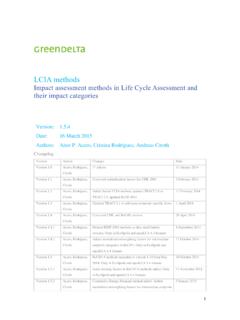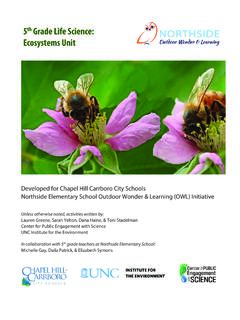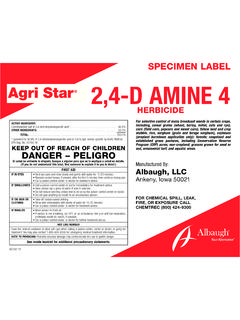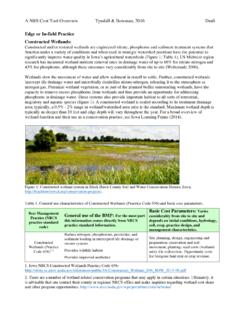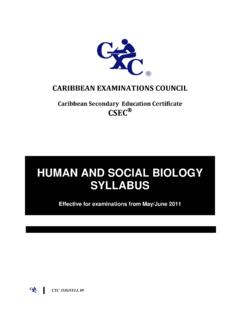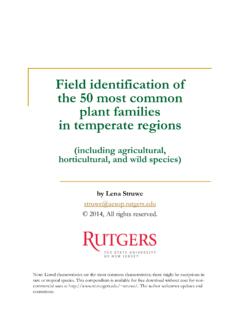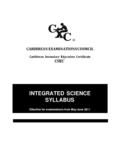Transcription of LCIA methods - openLCA
1 lcia methods Impact assessment methods in Life Cycle Assessment and their impact categories Version: Date: 11 May 2016. Authors: Aitor P. Acero, Cristina Rodr guez, Andreas Ciroth Changelog Version Author Changes Date Version Acero, Rodr guez, 1st release 31 January 2014. Ciroth Version Acero, Rodr guez, Corrected normalization factors for CML 2001 3 February 2014. Ciroth Version Acero, Rodr guez, Added Social LCIA method, updated TRACI to 17 February 2014. Ciroth TRACI , updated ILCD 2011. Version Acero, Rodr guez, Updated TRACI to add some ecoinvent specific flows 1 April 2014. Ciroth Version Acero, Rodr guez, Corrected CML and ReCiPe version 28 April 2014. Ciroth Version Acero, Rodr guez, Deleted EDIP 2003 methods as they need further 4 September 2014. Ciroth revision. Only in EcoSpold and openLCA formats Version Acero, Rodr guez, Added normalization/weighting factors for intermediate 17 October 2014. Ciroth endpoint categories in ReCiPe.
2 Only in EcoSpold and openLCA formats Version Acero, Rodr guez, ReCiPe 8 methods upgraded to version from May 30 October 2014. Ciroth 2014. Only in EcoSpold and openLCA formats Version Acero, Rodr guez, Some missing factors in ReCiPe 8 methods added. Only 11 November 2014. Ciroth in EcoSpold and openLCA formats Version Acero, Rodr guez, Cumulative Energy Demand method added. Added 5 January 2015. Ciroth normalisation/weighting factors for intermediate endpoint 1. categories in Eco-Indicator 99. Weighting reference unit corrected. Only in EcoSpold and openLCA formats Version Acero, Rodr guez, ReCiPe methods : deleted wrong FEP CFs, added missing 4 February 2015. Ciroth FETP End (I) CFs, added new FDP CFs (Update method to ). Only in EcoSpold and openLCA formats. Further information in: 1b08-4471-ab87-e6efd66702c9. Version Acero, Rodr guez, CML methods updated to : abiotic depletion impact 16 March 2015. Ciroth categories updated, CFs for new flows in reference date added, CFs which were originally from ecoinvent LCIA.
3 methods were deleted or updated. Only in EcoSpold and openLCA formats. Further information in: Version Acero, Rodr guez, Correction normalization factors for ReCiPe method, 22 March 2016. Ciroth based of December 2014 of method's provider ( major changes affecting Endpoint (I) and (H). methods ). 2. Content 1 Introduction .. 4. 2 How to use the lcia methods packs in openLCA .. 4. openLCA LCIA 4. Social Hotspots Database (SHDB) LCIA Method .. 6. 3 Environmental Impact Assessment methods .. 6. Impact assessment methods in the pack .. 6. CML .. 9. Cumulative Energy Demand .. 10. Eco-indicator 99 .. 11. Ecological Scarcity Method 2006 .. 12. ILCD 12. ReCiPe .. 13. TRACI .. 15. USEtox .. 15. Limitations .. 16. Impact categories .. 16. Acidification .. 17. Climate change .. 17. Depletion of abiotic resources .. 18. Ecotoxicity .. 18. Eutrophication .. 19. Human toxicity .. 19. Ionising 20. Land use .. 20. Ozone layer depletion (Stratospheric ozone depletion).
4 21. Particulate 21. Photochemical oxidation (Photochemical ozone creation potential) .. 21. 4 Social Impact Assessment Method .. 22. 5 References .. 23. 6 Contact .. 23. 3. 1 Introduction The availability of diverse sources for life cycle inventory databases and Life Cycle Impact Assessment (LCIA) methods should be an asset to better perform life cycle assessment studies. However, the variability of nomenclature used in each source for the compounds and compartments of the elementary exchanges impedes a straightforward combination of the different data. Thus, an intense work has been conducted for openLCA in order to align and harmonize the flows from different databases and lcia methods . The Nexus website ( ) contains currently over 30,000 data sets, from different sources, which can be used independently or combined in a single system in openLCA . And we are happy to be able to provide now a comprehensive pack of Life Cycle Impact Assessment (LCIA) methods suitable for all the data sets in Nexus.
5 This pack is meant to replace the previous impact methods archive that was kindly provided by ecoinvent, which was mainly addressing ecoinvent flows. In addition, a pack containing a social LCIA method is also provided in order to use it with the Social Hotspots Database, which is also available at Nexus. 2 How to use the lcia methods packs in openLCA . The packs with the different methods can be downloaded from the openLCA website ( ): openLCA lcia methods openLCA lcia methods are currently provided in three formats: ecospold1, .olca and .zolca. This is due to the impossibility of including normalization and weighting data in ecospold 1. format. Ecospold 1 and .olca formats are intended to be used with openLCA or previous versions. The .zolca format should be used with openLCA beta III version or later. In all cases, it is necessary that the databases using these lcia methods contain reference data from openLCA . Otherwise, the results of the impact assessment would be 0 for all categories.
6 Zolca file The zolca file should be used in version beta III or later. It contains characterization factors for the different impact categories and normalization and weighting factors for some of the methods (see section 3 for further details about the methods ). The .zolca can be imported as a new complete database or, in openLCA beta IV or later versions, into an existing database with reference data. In this last case, data already existing in the database would be maintained and the lcia methods would be included (fig. 1, 2). Please note that LCIA calculation results are only displayed in openLCA beta IV or later versions. 4. Figure 1. Option 1: Import .zolca file into an existing database Figure 2. Option 2: Import .zolca file as a new complete database Figure 3. Import ecospold 1 file into an existing database ecospold 1 file The EcoSpold01 file contains characterization factors for the different impact categories but not normalization factors.
7 It should be imported into an existing database in openLCA . containing reference data. As it does not contain normalization data, it is recommended to use it only when the impact assessment must be done in a previously created database using a version of openLCA previous to beta..olca file The olca file contains characterization factors for the different impact categories and normalization and weighting factors for some of the methods (see section 3 for further details about the methods ). It can be used in openLCA or previous versions. The file should be imported as a complete database in openLCA . The process data sets can be imported into the database afterwards. 5. Please note that openLCA databases can be migrated into the new openLCA database format ( .zolca) after installing the correspondent plugin: Figure 4. Migration of openLCA databases (.olca) to openLCA format (.zolca). Please be aware that the normalization and weighting results are currently only available using the Quick Results option in the calculation wizard.
8 Social Hotspots Database (SHDB) LCIA Method The SHDB method is provided in ecospold1 format. It does not contain normalization data and it is intended to be used with the Social Hotspot Database. As the elementary flows used are different to those in the openLCA reference list ( environmental elementary exchanges), it is not necessary to use a database with reference data. This file can be used with all openLCA . versions. Once the methods are imported, the LCIA calculation can be done as explained in the wiki: #Impact_Assessmen t 3 Environmental Impact Assessment methods Impact assessment methods in the pack By tradition, an LCIA method is understood as a set of LCIA impact categories. This is also reflected in openLCA , where you select an LCIA method prior to calculating a product system or project. In order to facilitate the choice of the method that better adapts to your needs, this section provides detailed information about each of the methodologies contained in the pack.
9 One of the main characteristics of the openLCA lcia methods pack comparing to the ecoinvent pack is the number of characterization factors included. As the ecoinvent pack mainly contains ecoinvent flows and compartments, the addition of specific flows from other databases and a general mapping of the compartments ( characterisation factor for air-high population density takes the characterization factor from air-unspecified if a specific value was not 6. provided) lead to a considerable increase of the factors available. Figure 5 shows the number of factors per method included in each pack. Figure 5. Number of factors per method and pack. Evidently, additional factors result of applying normalization and weighting factors in openLCA methods such as eco-indicator 99 and ReCiPe. The ecoinvent pack contains factors for a specific normalization and weighting set, whereas openLCA includes the factors without the normalization applied and then the factors needed for calculating the normalized results if required ( eco-indicator 99 (H) in ecoinvent is actually eco-indicator 99 (H,A) and openLCA .)
10 Provides normalization data for both H,A and H,H perspectives).Table 1 is an outline table describing the most common impact categories that can be found in the different methods . 7. Particulate Ozone Climate Resource Human Ionising Land matter/ Photochemical methods Acidification Ecotoxicity Energy Use Eutrophication Odour layer change depletion toxicity Radiation use Respiratory oxidation depletion inorganics CML (baseline) - - - - - CML (non baseline) - - Cumulative Energy Demand - - - - - - - - - - - - eco-indicator 99. (E) - - - eco-indicator 99. (H) - - - eco-indicator 99. (I) - - - Eco-Scarcity 2006 - - - - - - - - - - - - ILCD 2011, endpoint - - - - ILCD 2011, midpoint - - ReCiPe Endpoint (E) - - ReCiPe Endpoint (H) - - ReCiPe Endpoint (I) - - ReCiPe Midpoint (E) - - ReCiPe Midpoint (H) - - ReCiPe Midpoint (I) - - TRACI - - - - USEtox - - - - - - - - - - - Table 1: Availability of impact categories per method.
